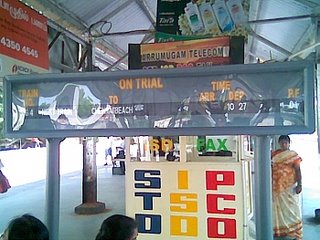Saturday, December 30, 2006
If you run a search for Chennai on YouTube or Google Video, you see some very basic videos of what this pattanam is famous for.
The crazy way Chennai remains mobile strikes me. There are some foreigners who have put in footage shot from cyclerickshaws and autorickshaws. Others have endangered their lives to shoot scenes of the "pride of Chennai," the 3 km long IT corridor, from the pillion of two wheelers.
I think the future lies with trains and buses, and the only rudimentary video of the city's elevated urban rail that I could locate on YouTube is by someone who goes by the name of Abhiramia:
Here it is
Though the video presents a very familiar perspective for the Chennaiite, to the visitor, it shows the often decrepit state of housing, the profilerating squalor and the generally dirty appearance of the city. Most of it is in Mylapore in the video. Catch a few glimpses of British-era buildings at Chepauk. The seemingly beautiful river is devoid of most river life species because it contains only sewage, fed in by the ever helpful Chennai Metrowater agency that is supposed to treat the city's sewage.
Wednesday, December 27, 2006
Union Minister Lalu Prasad Yadav's contribution to the so-called turning around of the Indian Railways is now the subject of study by two business schools, Harvard and Wharton.
There are few materials available on record to show that Mr. Yadav has implemented any special management measures that have led to a profitable spell for the railways.
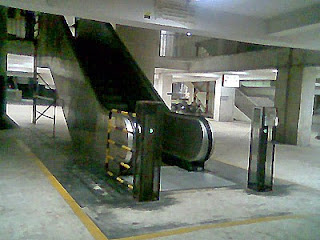
By most accounts, the Minister has been wise enough to leave the running of the gargantuan railway system to the somewhat reclusive set of professionals who make up the Indian Railway Technical Service and the Indian Railway Accounts Service.
As I have been repeatedly pointing out, Mr. Yadav and his less prominent deputy in the Ministry, Mr. Velu have done little for the Mass Rapid Transit System in Chennai. The picture shows it all. There is a lot of real estate in the MRTS stations, such as Chintadripet here. But it is completely wasted because the only occupants of the neglected building are some transport contractors and parcel agents for bus operators.
On most days, the approach to the station is dark, the entrance obscured from view by a proliferation of bushes and storm drains without covers that people fall into.
Not the kind of rail transit system that someone from Harvard or Wharton would imagine Mr. Yadav is running at a profit, or come to think of it, even at a loss.
Tuesday, December 26, 2006
At long last, it appears (just appears) that Chennai is moving ahead with a Metro rail project.
Here is A.Srivathsan's report in The Hindu on it.
If the DMK government is intelligent (which is unlikely in its present avatar) it will built a solid metro for the city and stake its claim to have revolutionised mobility in Chennai. The first step of involving the DMRC is positive, but the future course is hazy at present.
Srivathsan makes the important point that the MRTS in Chennai in a sort of stupor because the State Government sees no stake in it, and a similar attitude to the metro rail, bus and suburban rail options in the future will create another dysfunctional system. So far, the State Government has not shown any interest to go beyond its atrophied bus monopoly, the Metropolitan Transport Corporation.
Sadly, the two dravidian parties and the palsied Congress in Tamil Nadu cannot bring themselves to think beyond the immediate future and the filthy lucre that they can make from deals. The other parties, including those professing green credentials, only give the impression that they are perpetrating an elaborate hoax on the State.
There are others also who think that cheaper cars are not the answer to Chennai's mobility problem, metros and buses are. Here is a blog post that reflects this view.
Today's report in The Hindu gives the impression that there is little that the Chennai City Traffic Police can do to record evidence about motorists who cause accidents due to sheer arrogance.
The explanation of the Joint Commissioner of Police (Traffic) is on shaky ground for the following reasons:
The Police in Chennai and elsewhere is forever trying to convince the public that it is helpless and unable to perform in a civilised manner because others are not helping it to. In my view, it should stop whining and get down to work.
Tailpiece: It is an amusing thing that the Tamil Nadu government is an absolute ignoramus when it comes to Information Technology. The Government's website puts out a news item from the New Indian Express that claims Chennai City Traffic Police to have launched a website to tackle what is officially termed "traffic chaos." There is a hyperlink in the report to this site: www.cctp.org. Click on it and you get a surprise! It goes to some domain salesman, rather than any useful page from the Police. No wonder the hit-and-run drivers are laughing at the vulgarly muscular and uncouth CCTP.
Like many other new highways of "global" standards that are snaking across India to cater to the newly affluent and motorised classes, the East Coast Road connecting Chennai to Cuddalore is a monstrosity.
Unlike the developed world, where the onslaught of motorisation and road building has largely spared people from the risk of direct collision with vehicles, India's highways, many of them aided by international financiers like the World Bank, are built only for vehicles.
Too bad that they are planted onto landscapes where people have been living for generations. These roads rip through such communities without the courtesy of even a subway or overpass, for people to cross to the other side. There are also no exits from the highway, no detours to spare the villages.
Little surprise that an estimated 65 people died on ECR during 2006.
There is this nice video on youtube that provides a glimpse to the anarchy that characterises neoliberal India's tolled "superhighways". Note the two-wheeler riders and cyclists travelling on the wrong side, practically coming into the speeding vehicles, the ramshackle commercial and housing structures that exist close to the carriageway, the occasional three-wheeled autorickshaws that transport those who cannot afford the high cost of motorisation and the complete indifference of the vehicular traffic to people's safety.
Of course, the best on youtube on the state of India's road traffic is here
At the best of times, Chennai Central is a beehive of activity, to some a functional anarchy of teeming thousands who throng a stately building that is familiar to generations. It takes little imagination to realise that the major part of the passenger handling areas of this premier railway terminal were created during colonial rule (just as the British put in more rail tracks to expand their own interests than free India's leaders have been able to, to pursue theirs).
Two new things strike you at Chennai Central.
There are a couple of sleek-looking platform ticket vending machines of foreign manufacture on the portico in the entrance. Neither is functional as yet, and I doubt if they will be around for long. It is of course, debatable whether you need German-built machines when you have many people who can find gainful employment (remember that machines need to be refilled with tickets and change, which requires people, though fewer than to operate separate counters).
Then there is a bright green kiosk on the bus bay outside Chennai Central now. This belongs to that somnolent bureaucracy, the Metropolitan Transport Corporation that runs the city bus service. The objective is to dispense daily, weekly and monthly season tickets. On a weekday afternoon, I came across this kiosk, nicely and cosily shut. I learn that the passes and tickets are only available in the first fortnight of the month. It is a pity that MTC cannot use modern technology and a matching attitude for its operations: Its buses are ramshackle and dangerously old, dirty, unwashed and polluting. Its crews are surly, rude, abusive and unabashedly homophobic. Its bureaucracy is faceless, arrogant even in its obscurity and closed to reform. Above all, it is unredeemingly corrupt.
Saturday, December 23, 2006
Is there something inherently wrong about the way Indians have lived for four millennia? Apparently, there is nothing much to draw from a long history of civilisation in habitat or architectural terms, if you go by the rash of advertising in the Property Plus supplement of The Hindu.
The advertisers promise locales and lifestyles that are far removed from India's civilisational history.
Today's edition of PP has an advertisement explaining the Spanish vision of the Alliance Group, which is promoting villas with a hispanic flavour in suburban Porur (watch a video of this Spanish vision on the promoter's website). Each of these villas will cost Rs.65 lakhs to Rs. two crores and they are truly international in such dollar-converted prices. It is also interesting that this new prestige address will combine English gardens with Spanish villas, an esoteric mix that is expected to tickle the sensibilities of largely the newly rich Indian catapulted to prosperity by globalisation and liberalisation.
But be warned that these villas with their imaginary flamenco dancers, toreadors and Englishmen walking terriers on lawns are here on Indian terra firma. The gated denizens of Porur have no access to good sanitation for their area. Sanitation and health are issues that the English settled in the 19th century before they developed a vision of urbanisation.
The Alliances, DLFs and other carpetbaggers must focus first on fundamentals and learn from India's own civilisational record, on sanitation, community spaces, health and welfare before rolling out their fictional landscapes.
The more realistic picture is available from a neighbouring CMDA approved layout called Jeeva Nagar, which you can find here.
Thursday, December 21, 2006
Today's newspapers carry the story of the Tamil Nadu Government cutting sharply the money that cinema theatres can collect from patrons all over the State, from January 1, 2007.
The day's stories also include a major plan to revamp urban infrastructure in the Chennai suburbs and Madurai region, involving astronomical sums of money.
Sometime ago, Minister K N Nehru had stated to the media that the State had sought a huge sum to improve transport infrastructure in Chennai -- Rs.1,300 crores to be exact, under the JNNURM.
In all of these announcements, the poor pedestrian of the city gets next to nothing. Take the United Progressive Alliance government's Common Minimum Programme, JNNURM or National Urban Transport Policy and one finds a great deal of discussion on pedestrian facilities. But when it comes to forking out the big bucks, the man (and woman and child) on the street is nowhere!
Wednesday, December 13, 2006
A correction to a report in The Hindu published today says Railway Minister Lalu Prasad Yadav wants to raise the profits of the Railways by a few thousand crores.
The Reader's Editor says, "A sentence in "Garib Rath may run from all State capitals: Lalu" (December 11, 2006) was: "Mr. [Lalu] Prasad said his target was to increase the railway profit from Rs. 13.5 crore to Rs. 20 crore in the next fiscal." It should have been Rs. 13,500 crore to Rs. 20,000 crore."
My own contention is that Mr.Yadav has to only galvanize the Mass Rapid Transit System (MRTS) in Chennai, which is sitting on several hundred crores worth of property in this metro.
If the stations on this line are put to good use, they are sure to generate significant levels of revenue.

The picture here shows what could have been well-patronised shops in one of the MRTS stations (Chintadripet). Their sorry state shows that Southern Railway has little idea of how to improve its revenues.
Monday, December 11, 2006
Here's what London is offering everyone in the city on New Year's eve. Can our shortsighted politicians and bureaucrats imagine a situation like this in Chennai? If you get my point, I am talking about the distance yet to be travelled to have a decent transport service in Chennai that was Madras, India.

"Passengers throughout the Capital will be able to travel for free on these services during the prime festive hours, for journeys starting between 11.45pm and 4.30am.
In addition, the Mayor is funding free travel on selected National Rail services between midnight and 5am, particularly in areas with fewer Tube connections."
As you can see, the idea is that you don't have to drink and drive. Don't kill yourself and don't kill others.
In his blog post today, Harvard economist and popular blogger Greg Mankiw advises students to walk, in the face of some evidence published by the NY Times that bicycle helmets may put you at risk.
But how easy is it to walk in faraway Chennai?
Take a look at the picture below for the answer. It was taken in Chintadripet, Chennai, on the perimeter of the Napier or May Day Park.

What you see is a power cable running across a footpath (or sidewalk, as in the US) that is the size of a ribbon. This power cable is good enough to fry you to a crisp, if it leaks at any point, and remember that these are rainy days in Chennai, India.
Despite intensive research on Chennai's public health (including an ongoing study by the Harvard School of Public Health), this is the state of affairs in general. In Chennai, everything is fraught with risks. Including your car, as the incident involving three men in a Hyundai Santro proved on October 28.
I have always maintained, even in my email exchanges with the World Bank's India office that its money has been used to defeat the objectives of sensible and civilised urbanisation.
Here are some scenes that show that all the talk of modernising Chennai is only about commerce. A truly modern and civilised city must cater first to its people. But Chennai is focussed on automobiles -- a decadent, Americanised and people-unfriendly model that is actively aided by the commerce-building strategies of the World Bank and its cohorts.
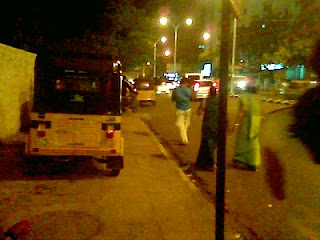
The scene below shows that the Chennai authorities, municipal, metropolitan development and police are all very tolerant towards encroachment of public space. The devotion to unlawfully exploiting footpaths is being condoned at the risk of the pedestrian losing life or limb.

Wednesday, December 06, 2006
This is the official record of vehicular emissions in Chennai, from the Central Road Research Institute, in 2003.
If this does not make people in this metro anxious, no one can save them.
Tuesday, December 05, 2006

Thursday, November 30, 2006
In April 2006, The Hindu reported that the Chennai Corporation is supposed to remove the silt deposited during clean-up operations by Metrowater immediately from the site.

People in Chennai have discovered these past few weeks that the Corporation is not willing to clear its own silt removed from the storm drains, not to speak of the filth deposited along the shrinking city sidewalks by Metrowater. That is something pedestrians have to live with even in the 21st century. As I have come to believe, Chennai's managers want only able-bodied, young, fully sighted, intrepid and rich men to use the vehicle-choked roads and broken down, trap-like sidewalks. There is no place for women, children, old, sick and disabled people here!
Today, The Hindu carried a photo of the indifference of the Corporation, on G.N.Chetty Road, T.Nagar. The story is the same in Zone Eight of the Corporation, in Kodambakkam (from Brindavan Street to Rajnikant's Raghavendra Kalyana Mandapam). Incidentally, this road is used by blind people to reach a hostel located near the Kalyana Mandapam.
Friday, November 10, 2006
So many people are breathless about Lalu Prasad Yadav speaking at the IIM about his stewardship of the Indian Railways and the profits it has shown.
If only Mr. Yadav would visit the Chennai MRTS line (locally referred to as the "flying train" because it is elevated along most of its alignment) to see how badly the Southern Railway is doing. It does not help Mr. Yadav that his junior colleague from the purportedly environment-loving PMK party, Mr. Velu is from Tamil Nadu.
One look at this station entrance at Chintadripet is enough to communicate how badly things are going for the MRTS and its commuters.
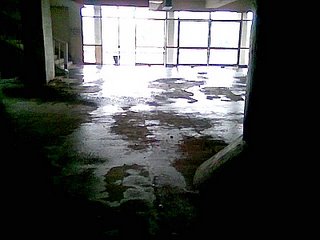
The ongoing monsoon has witnessed rainwater lashing the station entrance, close to the ticketing booth. Dogs seeking shelter have become regular inside the circulating area, and they don't hesitate to leave something behind, which there is no one to clean up.
There is no lighting inside the station other than in the concourse (circulating area), so you must approach the core of the station in pitch darkness. And here is the worst part: there are huge holes in the ground, into which you might fall and break a bone! Recently, I witnessed one man with his shin all bloody after falling into a drain pit that has no cover, near the in gate.
This is such a pity because the MRTS has built expensive stations that have tens of thousands of square feet of built up space, which can very well earn the Railways revenue. If not, they could be turned into park and ride lots, as originally planned. They could also be a combination of both. A few of the shop areas are today occupied by the cargo wings of bus operators. These are barely active at night, and only the workers loading materials are found here. Hardly the picture of a bustling commuter train station.
For a contrast, see this picture of the Westminster station opposite the British Houses of Parliament, that I took on a visit in mid-October this year.
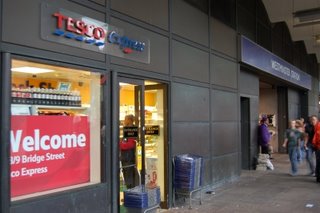
The MRTS is among the best examples of how Indian bureaucracy badly manages potentially profitable assets, even in an otherwise professionally-run technical service like the Railways.
Despite the high rental rates in the Central district of Chennai, these MRTS stations appear desolate and deserted. Most areas earmarked for commercial activity are empty. They are ghostly in appearance, dark, dank, dysfunctional and economically ruinous for the system. The rides are overpriced, especially in comparison with the bus. There is no integration with the city bus system, run by the Metropolitan Transport Corporation of the State Government. Even the condition set by the Central Government in India demanding that the States set up a transit management authority that will monitor integration of bus and rail has failed to evoke any response.
The irony is all the greater because India is among the countries that is contributing heavily to global warming and climate change. If it has successful rail systems, it will help the world cool down. It would also help many people in Chennai breathe easier and travel ethically.
That Chennai is a city with funny priorities is well known.
We have heard about the gifting of 100 air conditioned patrol cars by Hyundai Motor Company, and today comes the report that it will spread its 'goodwill' to other cities in Tamil Nadu.
But I would like to present to the world the classic face of the Chennai policeman, seen in this image.
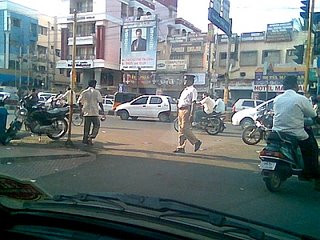 This scene at the junction of United India Colony Fourth Main Road and Arcot Road epitomises the kind of policeman that this squalid metropolis can boast of.
This scene at the junction of United India Colony Fourth Main Road and Arcot Road epitomises the kind of policeman that this squalid metropolis can boast of.What is the point of adding to the car fleet of such a poorly motivated, unimpressive, unprofessional, technology-illiterate and corrupt force ? What we need is policing with a more professional approach, better evidence gathering mechanisms to prevent corrupt elements cooking up facts and records.
The boom in the economy has only raised the incidence of bribe-taking, with little impact on the ramshackle, broken down road infrastructure, the lack of environmental support systems such as drains and canals, all of which have eroded the quality of life in Chennai. Of what use is 8 pc GDP growth when it means so little for the public?
Tuesday, November 07, 2006
Today's report in The Hindu states that the Hyundai Santro which killed three people on G.N.Chetty Road, T.Nagar is being analysed by experts to determine what had led to the fatal situation.
This report strangely makes almost no mention of the alleged failure of the locking mechanism, which is thought to have prevented the occupants of the car from either opening the windows or doors.
Meanwhile, many bloggers who have been gushing about the most modern Accent model patrol cars available with Chennai police courtesy Hyundai, will be disappointed to note that the City Police is yet to announce a protocol for their use.
For those who have little or no knowledge of how police in India work, it should be instructive to know that there is no effective quick response mechanism to distress.
Like 911 in the US, one must dial 100. Contrary to the perception that the control room has all the information about the caller based on the location from which he has dialled,(the caller might be suffering a heart attack or be in an accident or become victim of crime and need not be coherent), Indian emergency services will require a full report before they decide to act.
It is not surprising therefore that many victims or patients prefer to take the closest available transport option and rush to a hospital. In the case of crime, calling the police without adequate preparation (with monetary support, in most cases) may result in the victim being questioned and harassed.
So where do the Hyundai Accent patrol cars fit into all this? We must wait for the Police Commissioner to enlighten us.
Here are some more people who are breathless about the donation of 100 cars to Chennai police: Logesh Tamilselvan and Teakada who also quotes someone as saying that police will respond in three minutes to any emergency. Sorry teakada, my maths is not so good, but how can 100 cars cater to a population of approximately 5 million and reach all emergency spots in three minutes?
Even if you add all the vehicles now with the police (not over 1,000 for Chennai in any case), that still provides a ratio of one car for 5,000 people. I suppose one must call them and cry blue murder only when one actually happens! For all other requirements, call Apollo Hospitals?
I saw one of these new-fangled patrol cars the other day on Anna Salai, blaring the siren behind parked vehicles and then extracting some money for wrong parking. Nobody is defending wrong parking, but is this the three minute emergency that people are talking about?
Thursday, November 02, 2006
After last Saturday's disaster involving a Hyundai Santro car in which three people died, the media has been slowly piecing the story together.
Initially, the car brand did not surface in many reports. On Thursday, however, The Hindu reported the follow-up to the incident mentioning Santro clearly.
Today, The Hindu has a report that a Hyundai Santro caught fire in a residential area due to some electrical problems. At least the mainstream media is now acting more ethically and mentioning the car brand, rather than leave readers to guess which car was involved.
As a corporate entity with a major share of the Indian automobile market, Hyundai would have enhanced its credibility if it has responded to the issue and transparently acknowledged the problem, if there was one. That it has not, and it has confined itself to offering free cars to the enforcement authority in Chennai, the City Police speaks rather poorly of its ethics.
Monday, October 30, 2006
Hello,I am back after a short visit to the UK, and as you can imagine, with a lot of new perspectives on why Chennai has among the worst roads anywhere.
Of course, the 'top' issue being discussed about Chennai's roads is the death of three people in a Hyundai Santro car during the intense rain that hit the city on Saturday (October 28) night.
It did not help any of the lakhs of motorists (or pedestrians) on that dark and rainy night that the police in chennai had 100 new cars donated by the same company whose Santro turned into a coffin for three people.
So why do people in Santro cars caught in heavy rain end up suffocating to death? Read the Times of India's report on the incident in Chennai here.
A search on the Internet reveals that the Chennai incident was not the first. It happened almost in identical fashion -- in a Santro -- in Mumbai in 2005.
Today's The Hindu has a report on how this sort of thing apparently happens. But the report does not deal with the impact of the jamming of the central locking on those who were trapped. What role did this play in causing the deaths?
This question is important because Hyundai has a duty to explain to its tens of thousands of customers, what it did after the Mumbai deaths, to determine the cause of the technical problem. Did Hyundai fix the problem in subsequent production of Santro? Why has it not ordered a recall of all Santros fitted with similar locks to assess whether they need to be changed or repaired?
Okay, even if this is too much to ask in a third world country with a significant number of corrupt politicians, bureaucrats and policemen, why has not Hyundai advertised an emergency number for its car owners, which will provide help if they are stranded?
And what is the Government in this Detroit of India doing for the vast number of people who have purchased cars?
Why is the Automobile Association of Southern India not coming up with some kind of response to such a tragedy?
Monday, October 09, 2006
The ubiquitous three-wheeled autorickshaw generally runs riot on India's urban and semi-urban landscape. This poorly-engineered ramshackle contraption which serves a small purpose as a feeder transport in most places has again shot to global fame as Angelina Jolie and Brad Pitt's runabout in Pune.
See the picture of Brad Pitt looking out of an autorickshaw here.
Many will remember the crazy scenes from the James Bond film Octopussy in which Vijay Amritraj drives an autorickshaw (specially engineered for the venture) like a bat out of hell ferrying Roger Moore.
A rather longish treatment of autorickshaws is available here on Wikipedia.
On Chennai Roads, though, the story of autorickshaws is not so much fun. Many passengers lose their limbs, some die and others suffer minor injuries each day, as the yellow three-wheelers race along city roads. All passengers are fleeced by market forces because there are not enough buses and trains for passengers.
Saturday, October 07, 2006
Surf blogs a bit to see what there is about Chennai, and you come across something like this. Someone has suggested the banning of autorickshaws in Chennai because they are a traffic nuisance.
This is exactly the sentiment that has driven Chennai's traffic insane. People imagine that if we sell more cars and two-wheelers (which you would have to completely depend on if autorickshaws were off the scene) the road scenario will get better! Nothing can be farther from the truth. The sensible thing to do would be to ensure that autorickshaws operate safely and abide by the law, and to increase the number of buses.
Fellow blogger Vasudevan Deepak Kumar is totally out of depth here.
Let me begin this post by saying that I am completely in favour of buses. They hold the key to making our lives sustainable and they reduce our dependence on costly personal ways to get around town.
But what I find completely unacceptable is the manner in which the buses are driven in India. As someone who has lived in this country for four decades and more, I am familiar with the ways of our people. The bigger guy gets the right of way. The little guy who uses the road does not have a voice. He represents only the fare, if he chooses to use the bus. The question of buses existing for mobility of people is forgotten.
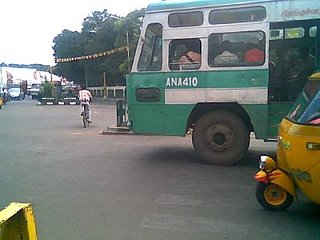 That is the kind of arrogance that one comes across in Chennai. Look at the Metropolitan Transport Corporation bus blocking off the pedestrian corssing in this scene at Periyar Bridge intersection on Anna Salai. There are at least three policemen here on duty all the time. Not one would care to even question such bus drivers. Finally, when government-run buses don't care for the law, will others feel compelled to? You can also see the faded zebra crossing lines in this picture.
That is the kind of arrogance that one comes across in Chennai. Look at the Metropolitan Transport Corporation bus blocking off the pedestrian corssing in this scene at Periyar Bridge intersection on Anna Salai. There are at least three policemen here on duty all the time. Not one would care to even question such bus drivers. Finally, when government-run buses don't care for the law, will others feel compelled to? You can also see the faded zebra crossing lines in this picture.
The first hour in the morning (around 6 am) is generally fraught with danger on the city roads. Today, I found that a lorry carrying bottled water had crashed into a street lamp near the Udhayam Theatre in Ashok Nagar. The area was strewn with glass and plastic, and the mangled lamp post blocked part of the road. I wonder whether the driver was drunk or sleepy?
Further towards Kodambakkam, I took a picture of the road intersection just outside the Ashok Nagar police station.
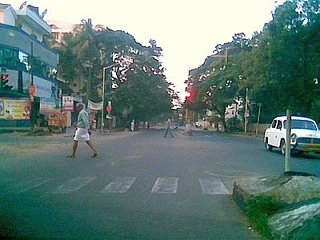 As you can see, there is no police presence and great caution is necessary in crossing the road. The fading "zebra crossing" markings are of little help, and the traffic signal, even less. It is extremely dangerous to imagine that motorists will obey rules at such intersections. Whether they are government buses, tourist taxis or private cars, most don't care about the traffic lights. So watch out!
As you can see, there is no police presence and great caution is necessary in crossing the road. The fading "zebra crossing" markings are of little help, and the traffic signal, even less. It is extremely dangerous to imagine that motorists will obey rules at such intersections. Whether they are government buses, tourist taxis or private cars, most don't care about the traffic lights. So watch out!
Safety is not one of the strongpoints of people in the Indian subcontinent. How else can one explain the unconcern about a large number of people dying in avoidable circumstances on railway tracks?
The general public view is that the railway stations in India have facilities that are hostile to pedestrians, and hence it is acceptable to take risks -- such as crossing over on tracks, rather than use an overbridge.
One cannot quarrel with the view of the commuters on the nature of facilities, but the risks can sometimes be too extreme. Today's The Hindu carries the report of three people getting killed in the suburbs, trying to cross the railway track.
Friday, September 29, 2006
Just a few days ago, I wrote about the death at dawn of an unknown motorcyclist at the junction of Inner Ring Road (Jawaharlal Nehru Salai) and Ashok Nagar Police Station Road.
I had called up the police control room and complained about the lack of supervision at 6 in the morning, when motorists are possibly at their worst behaviour.
Today, I was again passing through the same roads and found that traffic lights at the following junctions were simply ignored by the motorists:
Trucks, omnibuses and Metropolitan Transport Corporation buses threatened to run over people and ram into vehicles that took care to follow the lights, precisely at the same point where just a few days ago, one man had died.
I have been asking the following simple question to anyone willing to listen in the police establishment: if you have no intention to enforce the traffic signals, why do you switch them on early in the morning in the first place?
Don't the Police realise that it is better to tell motorists to "negotiate" carefully, rather than ask them to obey traffic lights? Otherwise, rogue drivers will not bother to stop at red lights and, as they have done in many instances, ram into you from behind?
It is horrifying that the average citizen is at the mercy of a system that is both completely non-functional and, for the most part, hopelessly corrupt.
Tuesday, September 26, 2006
I just saw that Paul Barter has excellent links to videos about traffic in South Asia and India in particular, on his blog.
It is worth looking at the impact of automobile dependence and absolutely, totally ignorant policymaking in India. Great stuff for those who may be visiting India. This is something that adds nicely to Google Earth. You know that when you land in those places shown in the maps, this is the terror that awaits you!
Chennai, like many other Indian cities, is going global. I am provoked to provide this cliched view of a city (that has had a rather long international association from the days of the somewhat disreputable Robert Clive) because there is now a visible post-independence population of "foreigners" here, all of whom have to literally breathe the local air, join the powerless pedestrians, use the roads, weave past obstacles and generally avoid being run over.
There are many who have to put up only with item number one. That is the air. Everything else one can buy in a "cleaned up" form.
This is something of an irony for the Hyundais, the Mitsubishis, the Fords, the Suzukis, the Fiats, Mercedes, BMW, Audi (and any other automobile company that will come to India), because they are all eagerly setting up automobile plants. These companies achieve the depressingly negative outcome of adding to global warming and reducing, ironically, the level of mobility in the city by crowding out cyclists and buses, while promoting gridlock.
To that list of course, one must add the local manufacturers of cars (Tatas...) and motorised scooters and bikes a few hundred of which hit the city roads everyday.
On Monday, I just missed taking a picture of a group of people of African origin being escorted across the road by an autorickshaw driver. It was a funny scene. The auto man had his hand raised in a gesture of helpless pleading as the flock of ageing visitors followed him. Everyone was nervous in the group. Not without reason, because motorists are usually impatient on the somewhat wide road with the red lights. Pedestrian crossings are usually ignored and there are no major subways available for several kilometres (between LIC and, say, Safire). This scene at the Spencer's Junction on Anna Salai (the famous Mount Road of yore) is, incidentally, supposed to be monitored by police closed circuit satellite television! Take it from me, it is money down the drain. The system does not work.
This is just my point. This city of flashy cars and discotheques is hopelessly barbaric when it comes to the roads. Yet, few businesses that set up here appear concerned about their impacts on the already deteriorating quality of life. I am not asking for their understanding. I am demanding that they realise social responsibility. I am not also xenophobic. It is just that we have a lot of problems from ignorant, unregulated, corrupt, unaccountable and completely greedy domestic businesses. We don't need further input of irresponsible capital powered by the deliberately weak state of the rupee and the seemingly insatiable appetite of Indian consumers to add to the chaos.
Fellow resident Scott Carney has a blog with a post on the state of chennai traffic, which I find has some interesting views. He is off the mark when it comes to some facts, starting with how much traffic police make (legally). Gone are the days when traffic policemen were paid less than a thousand rupees a month. Anyway, here is his take on some of the madness. Scott Carney Online
Saturday, September 23, 2006
On Saturday morning, what I had feared for long ultimately happened. At the junction of the chaotic Inner Ring Road and 11th avenue Ashok Nagar (leading from the local police station), a man lay dead.
He was a two-wheeler rider, one more added to the statistics of vulnerable road users who could not survive India's rapid slide into automobilisation and vehicle dependence. His body lay on the road, with policemen who had appeared in strength after the accident (road rules are not otherwise enforced on this busy road that caters to all of the traffic including thousands of buses and often trucks going from south to north).
Paul Barter, the sustainable transport campaigner and researcher whom I have met in Kuala Lumpur used to say that if you know the cause of something, it is not an accident any longer.
We know what killed the motorcyclist on Saturday morning. It was a combination of ignorance, indifference, lack of enforcement and finally, the rising tide of automobilisation in India.
The response of authority was revealing. A policeman on the scene was irritated with my questions. I asked, "Of what use is it for you all to be present after someone is dead?"
"The fellow was in the wrong....(expletive deleted)"
The Hindu, the most respected newspaper in the city did not report this accident (though its City Editor was informed about it).
Then again, for an idea of the kind of police that manages India, look at this image. The policeman is no better than the person to his left, standing in the fading zebra lines earmarked for the pedestrian!
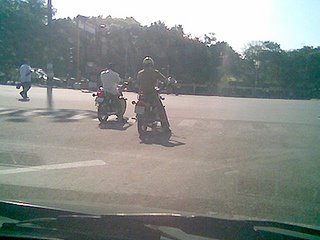
We stupid Indians...we will follow rules in Dubai, in Singapore, in the US and in London. Right here, where we live, where our kith and kin are exposed to danger on the road everyday, we are a hopelessly indisciplined lot. Is it any wonder that at least 80,000 of us will die in 2007 in road crashes and millions of us will nurse injuries sustained on the road?
Tuesday, September 19, 2006
This is an image change that qualifies for serious study. In the popular imagination, often embellished by media images, Lalu Prasad the politician is often laughed at for his "rustic" persona. Now Railway Minister Lalu has gone to the Indian Institute of Management at Ahmedabad to talk about the turnaround of the Indian Railway.
If commanders hold the key to the victories of armies, Lalu must certainly be commended for the book profits that the Railways have shown in the past year. It is of course, another matter that the Indian Railway -- even with an impressive record of moving millions -- is far from perfect. I have carried several pictures in the other posts on this.
But without pessimism or cynicism, let us hope that Lalu will preside over an administration that will professionalise and modernise the railways and attract more people to undertake train travel. That he will provide the ageing and antiquated suburban railway stations of Chennai with escalators, lifts, clean entrances, eating places, ticketing booths, park and ride centres, information systems on train shedules, routes and system maps.
Lalu's speech in Parliament on the Railways, during the budget presentation is worth reading, in the light of the kudos he is now receiving. It is found here.
Thursday, August 31, 2006
It is no exaggeration that a ride on a train in this country will provide an interesting glimpse of the diversity of its social life.
On a suburban train, one can see those who have been generally failed by the Indian welfare system, starting with blind people trying to sell cheap plasticky stuff to earn a living, fruit vendors, mendicants, street performers and vagabonds.
I saw this girl with a slightly older boy and a woman, presumably all from the same family, performing minor contortionist tricks on the train. The boy and girl danced briefly to the beating of a drum by the woman, then wriggled through tight metal rings, before seeking alms from the passengers. After their first act, the children were fascinated by the sight of another train moving in the same direction on the adjacent track, its horn loudly blaring. They smiled at each other and momentarily suspended their circus.
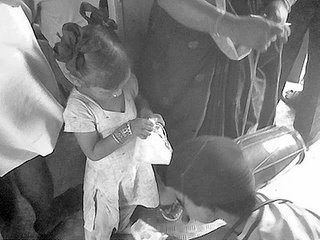
To the credit of most people, they parted with at least 50 paise, and I was quite sure that if this troupe could carry on with its act regularly (though that would be possible only until the kids remained 'small') they would at least stave off hunger.
It was funny to read in The Hindu the other day, that Chennai's monopoly bus operator, the Metropolitan Transport Corporation does not have a printed bus guide.
It was funny because the MTC many years ago produced not just a guide giving route information, but even a good system map. It appears that as technology advances, policy regresses and a well-run transport network has gone to seed.
Back to the question of travel and transit guides, I found an entrepreneur on board a Tambaram - Beach suburban train selling an interesting pocket guide for the wholly affordable price of three rupees. Besides a set of time-tables for the suburban rail system, it has details of the State Express Transport Corporation bus services, emergency phone lines for hospitals, 24-hour pharmacies and call taxi companies.
The guide contains the following address: English Tamil Publications, 29.81, Red Hills Road, Opposite Gupta Convent, Villivakkam, Chennai 49. Phone: (044) 2617 4439.
This nifty guide suggests that it would make an ideal hand-out for trade unions, film fan associations, political parties, residents welfare associations and so on. I completely endorse the value of such a publication.
Saturday, August 26, 2006
It is intriguing that the passage leading to the Kodambakkam suburban railway platforms presents a solid concrete stone bang in the centre. They are puzzled because the stone serves no apparent purpose.
Remember that at dusk, this passage is plunged in darkness and unless you are a regular commuter, you may not be able to spot this stone. The results of such failure are all too imaginable.
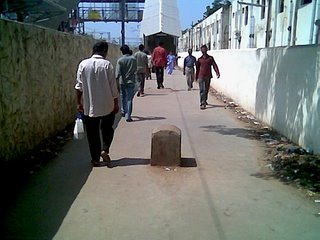
In the background is the staircase leading to the platforms. More about that later. I am riding a lot of trains these days and have come to call these staircases the "42 steps."
Here are a few pictures from the past couple of days. This is what Chennai's suburban railway looks like. More to come, of course.
A three car train that runs between Thirumailai (Mylapore) and Chennai Beach: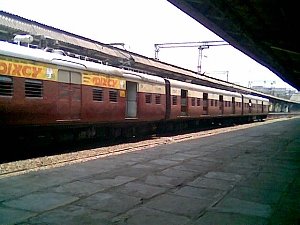
The new train information system installed with the sign "on trial" at Kodambakkam station. It did not appear to be too accurate and as you can see, there is no clock in the board itself. You would have walk further on the same platform to spot the clock! If this system had been electronic (as it is in airports and even some major Indian railway stations) many display terminals could be connected to show the same information. So why is the wheel being reinvented?
The inside of some of the more recently introduced trains on the Chennai suburban railway looks like this. Considering the ramshackle past, this is welcome, but it lacks system maps and wastes opportunities to communicate useful information to a large commuter population. Note the man squatting in the passage (partly seen). Quite common in Indian trains.
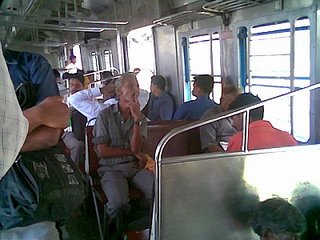
Tuesday, August 22, 2006
As the Americans call it, it is the railroad. We know it as the suburban train, and in London, it is the tube. To many others, the modern versions are the Metro trains.
Whatever moniker suits you, the train does a lot of good to Chennai. Only, it is still in its antiquated Victorian state, rather than modernise with the times just as the Ambassadors and Fiats have given way to the Marutis, Hondas, Fords, Skodas and Toyotas. Of course, Chennai's buses also remain hopelessly primitive and the design of even new bus bodies obsolete.
As someone who uses trains everywhere (I have had occasion to use urban rail in London, New York, Washington DC, Paris, Berlin, Hamburg, Munich and Hong Kong) I cannot help noticing the miserably archaic train system that we have in Chennai.
The only redeeming thing about the train is its capacity to carry a large number of people. Otherwise, it is simply, hopelessly outdated in terms of infrastructure and operations.
Here is a glimpse of a station for the most recently introduced train, running on the Mass Rapid Transit System line:
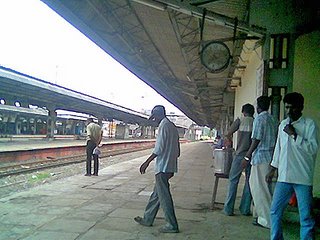
To be fair, this is Fort Station, which is at the surface level. Half a kilometre from here, the MRTS goes on to an elevated section.
But look at the non-working clock, the lack of any signages for passengers indicating basic train information. The ticketing systems are simply pathetic. One has climb a steep flight of stairs to reach the ticketing office and then move to the MRTS platform.
An example of the ticketing offices of the suburban train system in Chennai is this one, at Kodambakkam on the Beach -- Tambaram line.
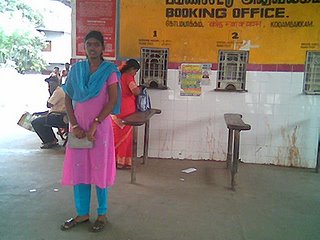
This office is deep inside the station, on the platform. The downside to that placement is that if you have a train coming in, you would have to sprint up to the office, to get your ticket and then jump on to the train. Being entirely manual, the ticket system is slow, involving a queue in most cases.
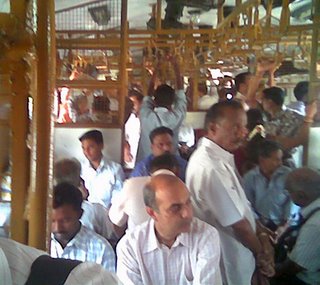
The worst disincentive to using the suburban railway system is the lack of automation in the form of escalators to reach the platforms. The approach to the suburban train stations, particularly those on the Beach - Thiruvanmiyur section, is invariably dark, dank and dirty. This puts off many potential travellers.
Monday, August 21, 2006
A week after the Hyundai Elantra knocked my car out of circulation, it was another Sunday. On a day like this, you become aware of how severely car-dependent you are, because India's (more particularly, Tamil Nadu's) policymakers have all but abandoned expansion of bus systems. Trains don't really present an alternative except for long distance commuting. That leaves us with autorickshaws.
Chennai's unregulated autorickshaw business is well-known. It is one of the costliest cities when it comes to hiring such intermediate transport. The fares approximate to between Rs.12 and Rs.15 a kilometre, arguably the highest in the country. The Governments led by both Ms.Jayalalithaa and Mr.Karunanidhi have over the last decade all but abandoned the need to regulate such feeder transport systems.
There is thus no functioning law governing autorickshaws. If you have lived here long enough, you know where you can bargain more effectively and save a few rupees. Trying to hail a crusing autorickshaw in most neighbourhoods is simply useless because the drivers recognise a monopoly principle for stand autorickshaws. Only after your negotiation with the local stand autorickshaws can you hire one that is cruising (and may hence make a more reasonable fare demand).
One of the reasons for this state of affairs is the long shadow of political parties on the transport sector. Let me explain: the major Dravidian parties saw early enough that given their inability to generate employment in most other sectors, urban transport was a means of providing a livelihood to the party faithful.
Thus, autorickshaw permits are secured by the middle rung city political leaders (and sometimes by those associated with leading film personalities) and the autorickshaws are handed over to people from the lowest strata to operate. Given the lack of education and any system of oversight, a high degree of lumpenisation exists in the sector. In fact, in the early 1990s, autorickshaws became the symbols of lumpen-led attacks on political and other opponents. The autorickshaws also demonstrate their affiliations on the vehicles in the form of flags, stickers of party colours, photos of the leaders and so on, all in violation of the Motor Vehicles Act rules. At the same time, few of them have functioning brake lights, headlights, windscreen wipers and indicators, as required under the MV Act.
Is it this vested interest the reason for not expanding the city's bus system, which has grown at the rate of about 100 buses a year for a decade, to serve a metropolis that has expanded in residential population terms by about a million and half people, and in area by a radius of 20 km in that period?
The robust economic growth of the country has accelerated the demand for transport in Chennai, but the Governments have preferred to encourage private vehicle ownership over provision of public alternatives. Private participation in Chennai's transport system is seen as politically unacceptable, although the families of Dravidian politicians own powerful private television networks both in India and abroad.
More on this later. Meanwhile, my car-free Sunday cost me and family Rs.200 by way of autorickshaw and bus fares.
Friday, August 18, 2006
For most city drivers, the world outside their car windows is a distant and remote place. But many such coccooned citizens in fancy cars come face-to-face with the inconvenient reality everyday.
I am talking about the scores of women and children who frequent the traffic intersections in Chennai, appealing to those inside the cars to buy vehicle-cleaning cloth, ear buds, in-car fancy dolls and other assorted stuff.

On Independence Day, I saw this woman who was going from car to car, trying to sell miniature India's national flag displays. These are usually intended to be kept on the dashboard, a public show of patriotism in a land that has failed many of its citizens even after nearly six decades of independence.
It is always worrying that some of these women and their children might come in harm's way, as they keep flitting between vehicles and scurry off just as the lights turn green.
Thursday, August 17, 2006
I remember the film White Line Fever, in which monstrous trucks race across America. The world has changed a lot and it is now possible to track down crazed drivers, but in Chennai, it is now Yellow Line Fever.
You might wonder what the purpose of these lines are. Police personnel occasionally take the trouble of painting these lines, continuous yellow or broken yellow and broken white lines that are supposed to mean something to drivers.
But not in Chennai.
Look at the response of drivers to plastic bollards that have been placed by traffic police on Anna Flyover at Gemini, and you get an idea of what I mean.
Earlier, we had traffic ignoring the double yellow lines painted on the flyover, and going the wrong way into T.Nagar. They closed that entry at night, because vehicles began to have head-on collisions.
Then, the police have a set of cones on the lines, to demarcate the two halves of the road. Many of those cones were crushed by drivers with impunity. After all, what do a few cones mean in a city that has no rules? People don't even stop at red lights here!
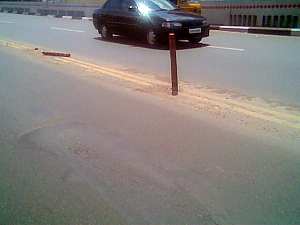
So the police got plastic bollards, thin red cylinders about a couple of feet tall. We have seen even these getting crushed, because no one in the traffic police is ready to wait on the flyover and get the Mad Maxes who are knocking them down and crushing them!
Look at the Lancer car in the picture, straddling the broken white lines, ignorant of what they are supposed to mean. The British brought the automobile to India, but they never taught Indians what lane discipline means. If you are getting very hot under the collar because I talk of the British, why not show me Indian leaders who have done better?
Wednesday, August 16, 2006
How do you like this picture of some youths of Chennai riding on top of a city bus, celebrating in a style that may not be common in much of the civilised world?
Riders do hang out of buses for want of space during peak hours, but I watched these urchins generally making a nuisance of themselves and keen on attracting attention through such antics. But in a country where it is difficult even to get your 15 minutes of fame, perhaps they don't have much choice!

It was Independence Day and I was out on the road, without a car but many a care.
My mobile phone camera kept clicking pictures of Mera Bharat Mahaan. In a bus, looking at the dirty Cooum (river) behind the posh Connemara Hotel... Here is one picture of what is left of the footpath or sidewalk at Chennai's best known junction, Arts College.
If it will impress you, this atrocity on pedestrians has been perpetrated with the help of the World Bank, which has been loaning funds to the Tamil Nadu Government in the name of improving civic infrastructure!

I had started this blog after a bad accident in which the personal driver (Indian) of a Korean executive of the Hyundai company rammed an Elantra car into my small, meek, fuel-sipping Maruti 800 car on August 13, 2006.
That post seems to have disappeared, so I am trying to recreate it here.
As a buckled-up, bespectacled and somewhat timid (on the road) driver who is always at odds with the drive-as-you-please Chennai traffic, my experience on the road took a great turn for the worse on that day.
A small town fellow, who gave his name as just Ravi proved my worst fears about Chennai traffic true. This ill-trained person at the wheel of a shiny wine red Elantra jumped the red signal at the junction of Music Academy on Radhakrishnan Salai and rammed his car into the side of my six-year old Maruti.
I was following the green light and going with two occupants in the car towards Marina.
Unlike the God after whom my pint sized car is named, the Maruti is a weakling when it comes to meeting metallic monsters in road combat.
Therefore, this is the result:

If you looked around the car, you would find that it does not have any dents elsewhere, in the six years that it has been on the road.
All that it took to spoil that reputation is one "classic" Indian driver called Ravi. This man said he has a licence issued in Arni, a small textile town in northern Tamil Nadu not particularly famous for the civic sense of its drivers. Surely, not now.
The occupant of the Elantra at the time of the accident, a Korean woman was completely engrossed in her own affairs, and she was content, as we found, talking to someone on the phone seated in the luxurious car. It mattered little to her that her personal driver had nearly killed three people after jumping a red light.
Perhaps people don't bother about traffic lights in South Korea - or at least, those who are executives in Hyundai motors don't. What is worse, Koreans don't seem to have basic courtesy, if this lady is a model South Korean.
If you are upset reading this particular part of the post, then you should sit inside one of the cars that Hyundai uses (presumably they do) for crash tests. It might give you some idea of what it feels like to be banged against some object.
Anyway, back to Ravi, who kept repeating after the accident that he was driving a car that belonged to a "Hyundai owner," which was shorthand for the few traffic policemen who had gathered, that his employer was an influential person. So watch out, he was essentially telling them.
Since my own car belongs to a major newspaper in this city, the police were in something of a quandary. They were relieved, in the event, to hear that they would only have to issue a certificate for insurance purposes, and not register a First Information Report and pursue the case and prosecute Ravi.
All this should give you an idea of what Chennai roads are like, when it comes to -- sorry for the pun -- crunch. Incidentally, the road where the crash took place leads to the houses of both the present and former (and possibly the future) Chief Ministers of Tamil Nadu.
I called up a colleague and he sought the good offices of a senior police officer to get the insurance certificate issued quickly. After all, since Ravi was going to go scot free despite attempting to murder three people using a Hyundai Elantra, why waste time with the formalities?
So a somewhat bored head constable was asked to accompany me as I drove the battered Maruti several kilometres, to the J 2 Adyar Traffic Investigation unit at Besant Nagar. The certificate took only a short while to obtain. One must remember that the accident had taken place in full view of three or four traffic policemen, and at least 20 law and order reservists who were sitting inside a police truck, at the Music Academy junction. Why had not a single policeman stopped Ravi is of course less of a mystery, because that is the way Chennai (and much of India) works.
In all of this, I must say that the seat belts of the Maruti really did their job. Neither me nor my kid in the front left seat (the side that took the hit) were shaken seriously, but a passenger in the back was thrown to the opposite side and left with some minor sprains and bruises in one arm. So never drive without the seat belt fastened.
If you wanted to look at the stupidly driven Hyundai Elantra car this is it:

The boot is ajar because the broken bumper of the car has been placed inside by the deviant driver.
Let me say at this point that I don't care much for cars, and think they are all contraptions that are only useful to get from point A to B. In fact, I believe it is criminal to sell such monsters in large numbers in a poor country like India (yes, despite the tall talk of India shining and superpower status etc), to drink up precious fuel for the pleasure of a few (like the lone Korean woman inside this one), while the bulk of the people in Chennai are sweating it out in ramshackle buses and overcrowded trains. Perhaps if we had air-conditioned buses and trains operating at affordable fares (without long waiting times), and they were funded by taxing such profligate consumers, I would not feel so bad.
All of which brings me to my pet raves and rants.
I am a proud advocate of public transport, car pools, ride shares, congestion charging and costlier fuel. I just love those good trains, buses, trams and the wide sidewalks (or footpaths if you wish).
You will find these themes recurring in this blog. So don't go away!
Monday, August 14, 2006
I thought I should share the police certificate on the car crash. Here it is, in pdf form. If you drive a vehicle and haven't seen a certificate from police to claim insurance after an accident (involving no injury, because if someone is injured, an FIR is registered).
Given the credibility of the enforcement mechanism of India's Motor Vehicles Act rules, the rash, negligent and arrogant driver of this car will not pay any penalty, other than the palm greasing that he did on the day of the accident. What is worse, he quickly sought the help of a off-duty constable to plead his case with me, urging that I should only ask for insurance money, and not file an FIR which would lead to a police investigation. Helps everybody, doesn't it? So Ravi can drive another of these cars stupidly and crash into another guy like me. Anyway, companies like Hyundai are there to bail out such untrained drivers who are employed practically as manservants in the house of the executives
We all know that Onyx, the international "waste specialists" who claim to have the best environment technologies elsewhere in the world, work only to transport trash in Chennai from houses to a dump in South Chennai, at Perungudi.
I have a picture of an Onyx three wheeler piled high with trash, most of it rotting vegetable waste, speeding up on G.N.Chetty Road.
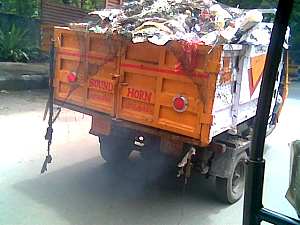
So here's the image. Today is Wedneseday, August 16. This is the way Onyx carries much of the trash from parts of Chennai to the transfer stations, and from there, it is carted to the dump.
